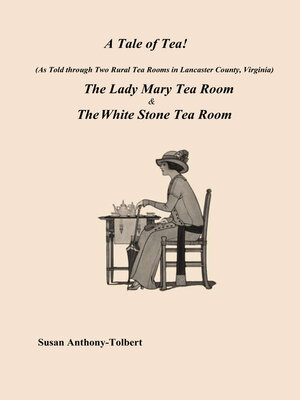A Tale of Tea
ebook ∣ (As Told through Two Rural Tea Rooms In Lancaster, Virginia)
By Susan Anthony-Tolbert

Sign up to save your library
With an OverDrive account, you can save your favorite libraries for at-a-glance information about availability. Find out more about OverDrive accounts.
Find this title in Libby, the library reading app by OverDrive.



Search for a digital library with this title
Title found at these libraries:
| Library Name | Distance |
|---|---|
| Loading... |
If you like tea and like having quiet chats with friends and family in a home-like setting over a cup of the brew or you would like to know more about the history of tea rooms throughout the U.S., "A Tale of Tea" as told through two rural tea rooms in Lancaster County, Virginia might be a good read for you. These two tea rooms were found in the Northern Neck of Virginia: a peninsula on the eastern side of the state. The area is certainly rural and at the time of the tea rooms was mainly accessible by water. That such a Southern area was able to support two tea rooms, though briefly, supports the popularity or 'craze' of tea rooms in the early to mid-20th century.
The book begins with a discussion of the discovery of tea as a drink; its unique history, its growth and harvesting; and its increase in popularity over centuries. The various types of tea are presented along with some information on oxidation and how it can influence the tea in our cups. Tea consumption in the American colonies and interesting sidebars on the Boston Tea Party are mentioned. The reader may be surprised that we didn't always have tea bags! The book explains how and by whom these were developed and explores the often ignored contribution of two women in the early 1900s to that development.
Though there were tea rooms in the United States as early as the late 1800s and extending into the 1940s, the 'heyday' for the tea room movements was in the 1920s. These early years of the 20th century were an interesting period in history: the Spanish Flu; World War I; the fight for women's rights; prohibition; and the proliferation of automobiles. However, the heyday of the tea room movement slowed with World War II.
Establishing a tea room of their very own was a step for women to emerge as more independent in the early days of the 20th century. These were basically run by women for women! Many of the earliest tea rooms in the U.S. (turn-of-the-century through 1920s and 30s) could be found in homes or in converted freestanding abandoned buildings such as barns, storage sheds, mills and yes, even gas stations. The location and placement were only limited by the imagination of the women who would design, decorate, own and manage them. Three types were prevalent during this time: the home-based tea room set up in a dining room or living room in the house of the lady owner/manager; the stand-alone tea room like the Lady Mary Tea Room in the center of Kilmarnock; and the gas station/tea room like Gregg's Gas Station-Tea Room in White Stone (aka The White Stone Tea Room).
The particular emphasis is on the Lady Mary Tea Room in Kilmarnock, Virginia which was in operation in 1924. However this was not the only tea room in Lancaster County, Virginia. There was also the White Stone Tea Room, in White Stone Virginia in the early 1930s. It should be noted that these were the only two tea rooms found on the Northern Neck of Virginia in this research on this time period. Both these eateries were part of the tea room movement in the United States and reflect the importance of this movement ... sometimes overlooked or under-explored, both in history in general and in the history of restaurants.
Advice to women (whose dream was their very own tea room) proliferated in popular magazines and newspapers of the early 1900s through the 1930s. These articles included the types of food to be served and the development of menus; the clientele preferred (mostly women though exceptions are discussed) and information on sound business practices. The link of tea rooms to the improvements of automobiles and roads is explored. It should be noted that tea rooms and their services are not the same as...







